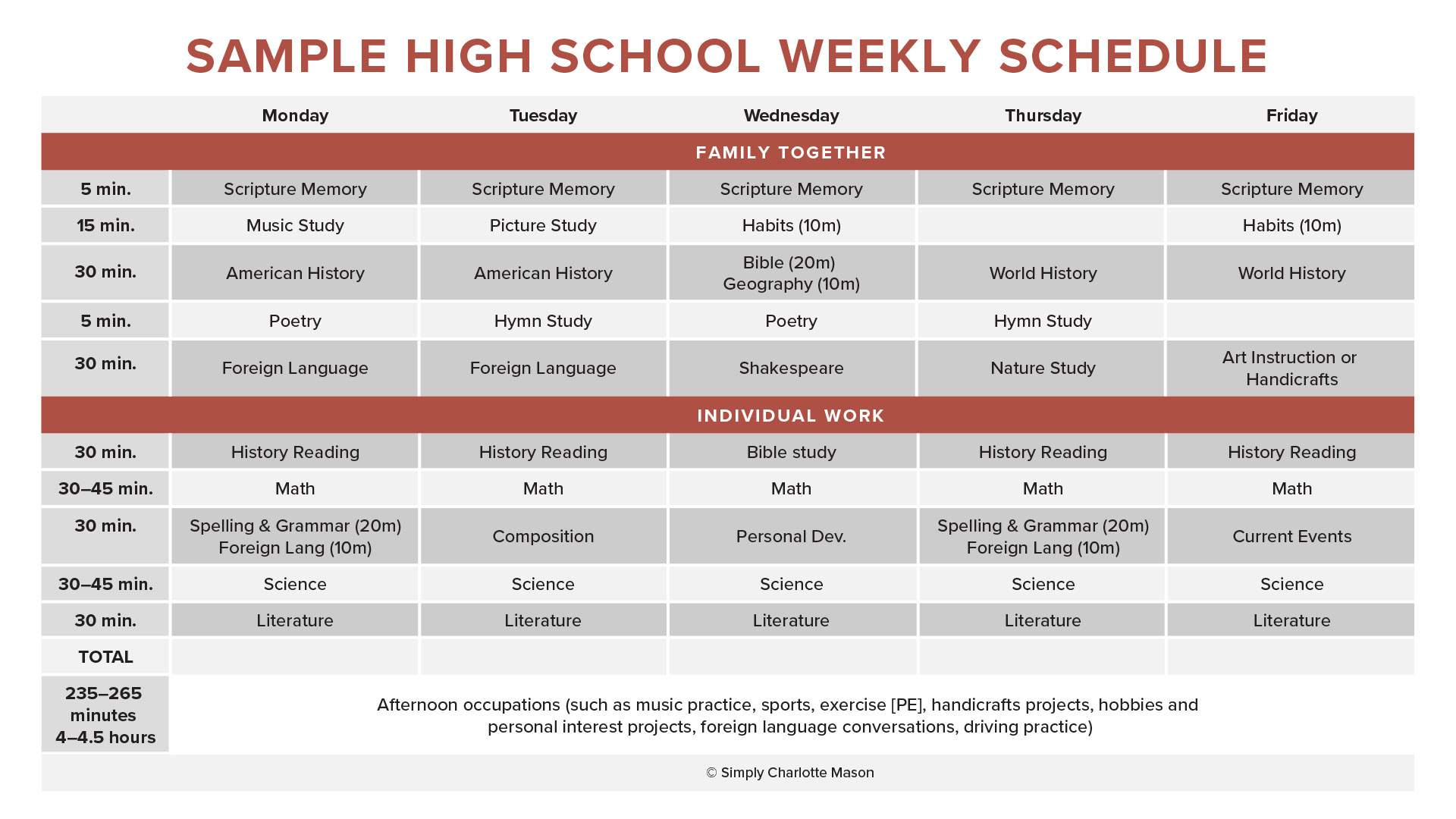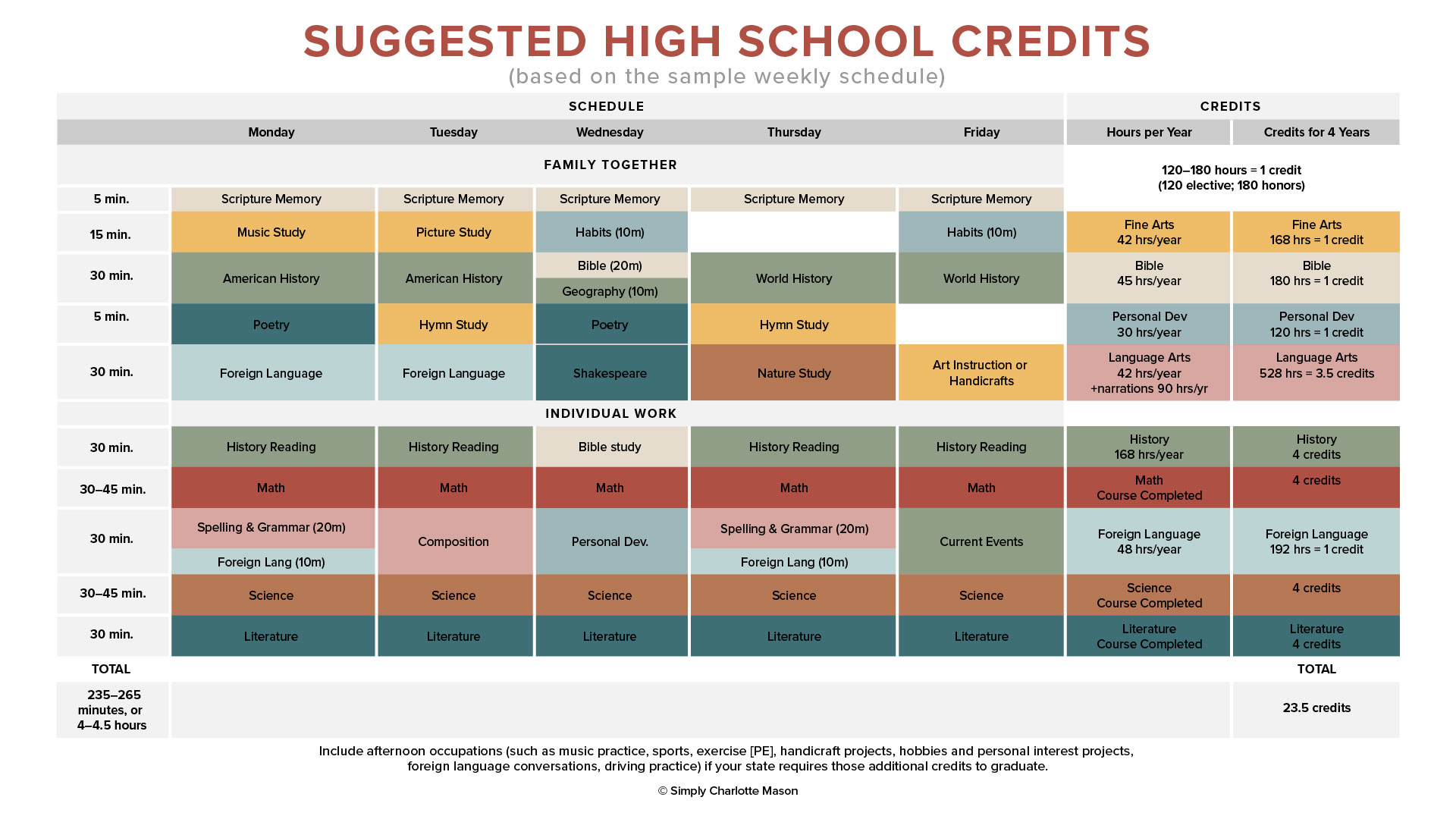Free shipping on USA orders over $129!
Those of us who attended a typical high school for seven hours a day might find it difficult to wrap our minds around how a Charlotte Mason approach can work for high school. If we use the concept of short lessons, that we discussed last time, will a high school student be able to earn all of the credits he needs to graduate? Can he really do that in just four hours a day? Let’s take a look.
Today we’re talking high school schedules and earning credit hours for graduation. If you look at high school graduation requirements across the 50 states of America, you will find that expectations vary widely. Some states require 17 credits to graduate; others require 24. And the number of credits per subject fluctuates as well. So check your state’s homeschooling laws to find out what is expected in your area.
Let’s talk about how a student earns credits. He can earn them in two ways: by completing a high-school-level course or by adding up the hours he spent studying a particular subject. In a Charlotte Mason approach, I like to combine the two approaches. Subjects such as science and math are easy to do as “course completed.” But language arts, with all of its components, or fine arts, which includes picture study, music study, and art and music instruction—those often work better by calculating time spent.
How much time? Anywhere from 120–170 hours of study in a given subject equals 1 full credit. Usually 120 hours are considered enough for elective courses like fine arts. The top end, 170 hours or more, is considered an honors level course. So the average or typical course can earn one full credit for 150 hours spent studying that subject.
Now, here’s the fun part. Let’s take a look at a sample high school schedule based on Simply Charlotte Mason curriculum, and see how it adds up.


You’ll notice that the day’s work is divided into Family Together subjects at the top and Individual Work at the bottom. Looking down the left side, you’ll see those short lessons. Many are in that 30–45 minute time range, which is the maximum recommended for this age group; but several are shorter than that.
This kind of schedule might look strange compared to a typical high school classroom. If your high school years were like mine, we had only about six subjects on the schedule each day, and every class time was about an hour long. The Charlotte Mason approach is different. It offers a wider variety of subjects delivered in shorter lessons.
You can see time slots for Bible, music, art, history, geography, poetry, singing, foreign language, Shakespeare, nature study, handicrafts, math, language arts, science, literature, personal development, and more. Yet all of those subjects add up to about four or four and a half hours of study per day. If you start at 8:30, you’d be done by 12:30 or 1:00.
Charlotte’s premise was this:
We are able to get through a greater variety of subjects, and through more work in each subject, in a shorter time than is usually allowed, because children taught in this way get the habit of close attention and are carried on by steady interest.
School Education, p. 240
Notice at the bottom of the schedule that it lists “afternoon occupations.” Although Charlotte’s students were done with their formal lessons by lunchtime, she didn’t want them lounging about all afternoon. She expected them to occupy their time with a variety of activities in more of an informal learning atmosphere.
Afternoons are a great time for students to practice musical instruments, to get involved in sports or other physical exercise, to work on handicraft projects of their choice, to spend time in conversation with a native speaker in order to practice their foreign language skills, or even to learn how to drive a car.
Afternoon occupations allow the student to pursue his own interests outside of formal lessons, but keep in mind that many of those occupations can count toward credit hours for fine arts, or PE, or other subjects.
All right, now that we’ve looked at a sample weekly schedule, let’s dig into the time involved and see how it adds up in terms of credits.


Here is the same schedule, but I have color coded it according to school subject. You see, many of the shorter lessons can be combined as components of a single subject. For example, take a look at the yellow time slots: music study, picture study, hymn study, another hymn study, and art instruction or handicrafts. All of those can be considered part of a fine arts course. So if you add up the two 15-minute slots, two 5-minute slots, and the 30-minute slot, you get 70 minutes per week that count toward a fine arts credit.
Look over at the right-hand side of the schedule, and you’ll see two columns that detail the credits. They match the color coding on the schedule and give you the total hours per school year and how those hours translate into credits over the four years of high school. So with our 70 minutes of fine arts studies per week, that adds up to 42 hours per school year. Continue that over four years, and you accumulate 168 hours of fine arts studies. That’s a full credit; in fact, close to an honors credit.
Do you see how it works? Let’s look at language arts: the pink time slots. In a language arts course, you can include spelling, grammar, and composition lessons from the schedule. You can also include the narrations that your student gives each day. Narrations are oral or written composition drafts. Those count. If you estimate conservatively that the student does three 10-minute narrations per day, that adds up to 90 hours of narration per year. Combined with the spelling, grammar, and composition lesson hours, your student ends up with 528 hours of language arts studies over the four years of high school, which translates into three and a half credits.
Notice also that some of the subjects on the Credits columns are listed as simply “course completed.” Remember, that’s another way to earn high school credit: by completing a high-school-level course in that subject. We’ve used that method for math, science, and literature. In literature, you can include all of the reading of literature books that your student has done, as well as Shakespeare studies and poetry studies. I count literature as a course completed because my friends who teach in private classrooms (not Charlotte Mason schools, but other private schools) tell me that most of their students have not read a single complete literature book. They’ve been given excerpts from various books during literature lessons, but they’ve never read a whole book before!
In a Charlotte Mason education, your student is reading multiple excellent literature books every year, plus studying a Shakespeare play and getting to know a classic poet and his poems. I think that counts as a high-school-level course completed.
You can download the high school credit chart and look it over in more detail if you’d like to. But let’s jump to the bottom right corner and look at the total credits earned for formal lessons over the four years: 23.5. That’s a lot of credits from four hours a day and short lessons!
If you are in a situation where you need more credits, include the hours spent in afternoon occupations. For example, if your student is taking music lessons, you can include the hours of practice and the time spent at those lessons. Add that time to your Fine Arts total to bump up the credit for that. This is also the place you can add credit hours for physical education or add more foreign language practice to increase that credit.
So, yes, it is possible to keep the Charlotte Mason approach of short, focused lessons even throughout the high school years. A four- or four-and-a-half-hour day of full attention, with a careful schedule that offers a wide variety of subjects, is enough for high school work. Add in the afternoon occupations and life experiences, and your student will have an enjoyable and enriching education that will keep his love of learning alive, will respect him as a whole person, and will set him up for success in life.
Here’s another resource I think you’ll find helpful. It’s called Your Questions Answered: High School, and it includes more guidance with credits and scheduling. It also walks you through creating a transcript, how to help your high school student with time management and much, much more.
Podcast: Play in new window | Download
Podcast (podcastv): Play in new window | Download
